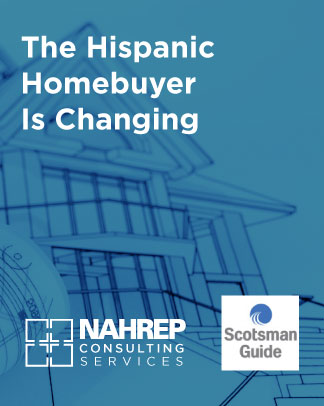If there is any doubt on whether or not the Hispanic market is a solid business strategy to grow your market share, then you haven’t heard these stats:
- 13 million of the 17 million projected new households between 2010-2025 will be diverse, of which 40 percent will be Hispanic
- Since 2000, Hispanics have accounted for 52 percent of the growth in U.S. homeownership
NAHREP Consulting Services talks to a lot of lenders, real estate professionals and others that are part of the home-buying experience. Most recognize that the Hispanic market is a solid business strategy but are still very hesitant to fully engage for a variety of reasons. At the top of that list is the confusion around whether or how to use the Spanish language.
Let’s be clear: over three-quarters of all U.S. Latinos speak English well or very well. The answer as to whether your company should invest in language really lies in how your customers’ prefer to conduct business. There is, however, research from a recent NAHREP membership survey that showed half of respondents’ clients require Spanish as a main language in the home purchase transaction. You may ask why, if so many people speak English?
- It is a matter of preference, not ability. Just as some clients prefer face-to-face versus online or vice versa doesn’t mean that they cannot or won’t do business other ways; they just will gravitate towards the companies that can serve them in the manner they prefer.
- Language is a power tool in building trust. The Goethe Institute has interesting research on this very topic: “Those who speak the same language not only can make themselves understood to each other; the capacity of being able to make oneself understood also founds a feeling of belonging.”
- Having professionals speak the language, if asked, and having materials (especially educational in nature) will make customers more comfortable. Let’s face it: our industry is a confusing one! Customers need to feel as comfortable as possible in what is likely the biggest investment of their lives.
- Many Hispanics live in extended family situations, meaning relatives are likely to be in the same household. Because you have multiple generations in the home, the language spectrum is likely to be mixed. Like most purchasing decisions, buying a home is a family affair and to be respectful to the culture would mean including the family in the process. Spanish would be a must for newer immigrant members or older generations.
- Finally, somewhat similar to the concept of comfort, having professionals, collateral and other resources available in-language provides transparency. Companies that demonstrate they want their clients to understand the process and to be well-informed every step of the way are companies that wants to be transparent. This will lead to a much happier client and one that will refer their friends and family again and again!
Language is one of many cultural elements, but probably the most powerful one and the gateway to the other aspects of culture. Hopefully you’ll consider language as a way to build rapport with consumers, and not a barrier between you and the consumer. What’s your strategy?






